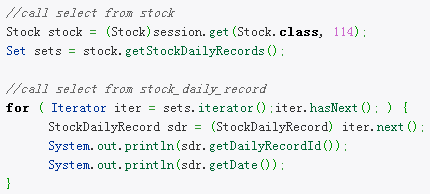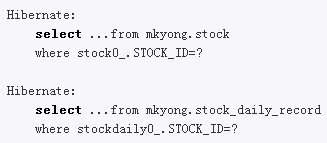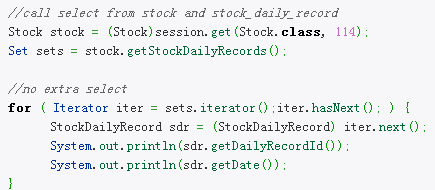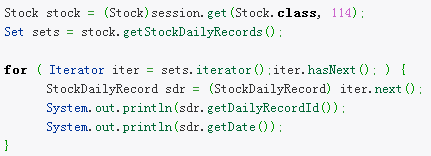Hibernate – Fetching Strategies Examples
Hibernate has few fetching strategies to optimize the Hibernate generated select statement, so that it can be as efficient as possible. The fetching strategy is declared in the mapping relationship to define how Hibernate fetch its related collections and entities.
Fetching Strategies
There are four fetching strategies
1. fetch-”join” = Disable the lazy loading, always load all the collections and entities.
2. fetch-”select” (default) = Lazy load all the collections and entities.
3. batch-size=”N” = Fetching up to ‘N’ collections or entities, *Not record*.
4. fetch-”subselect” = Group its collection into a sub select statement.
For detail explanation, you can check on the Hibernate documentation.
Fetching strategies examples
Here’s a “one-to-many relationship” example for the fetching strategies demonstration. A stock is belong to many stock daily records.
Example to declare fetch strategies in XML file
Example to declare fetch strategies in annotation
Let explore how fetch strategies affect the Hibernate generated SQL statement.
1. fetch=”select” or @Fetch(FetchMode.SELECT)
This is the default fetching strategy. it enabled the lazy loading of all it’s related collections. Let see the example…
Output
Hibernate generated two select statements
1. Select statement to retrieve the Stock records -session.get(Stock.class, 114)
2. Select its related collections – sets.iterator()
2. fetch=”join” or @Fetch(FetchMode.JOIN)
The “join” fetching strategy will disabled the lazy loading of all it’s related collections. Let see the example…
Output
Hibernate generated only one select statement, it retrieve all its related collections when the Stock is initialized. -session.get(Stock.class, 114)
1. Select statement to retrieve the Stock records and outer join its related collections.
3. batch-size=”10″ or @BatchSize(size = 10)
This ‘batch size’ fetching strategy is always misunderstanding by many Hibernate developers. Let see the *misunderstand* concept here…
What is your expected result, is this per-fetch 10 records from collection? See the output
Output
The batch-size did nothing here, it is not how batch-size work. See this statement.
The batch-size fetching strategy is not define how many records inside in the collections are loaded. Instead, it defines how many collections should be loaded.
— Repeat N times until you remember this statement —
Another example
Let see another example, you want to print out all the stock records and its related stock daily records (collections) one by one.
No batch-size fetching strategy
Output
If you have 20 stock records in the database, the Hibernate’s default fetching strategies will generate 20+1 select statements and hit the database.
1. Select statement to retrieve all the Stock records.
2. Select its related collection
3. Select its related collection
4. Select its related collection
….
21. Select its related collection
The generated queries are not efficient and caused a serious performance issue.
Enabled the batch-size=’10′ fetching strategy
Let see another example with batch-size=’10′ is enabled.
Output
Now, Hibernate will per-fetch the collections, with a select *in* statement. If you have 20 stock records, it will generate 3 select statements.
1. Select statement to retrieve all the Stock records.
2. Select In statement to per-fetch its related collections (10 collections a time)
3. Select In statement to per-fetch its related collections (next 10 collections a time)
With batch-size enabled, it simplify the select statements from 21 select statements to 3 select statements.
4. fetch=”subselect” or @Fetch(FetchMode.SUBSELECT)
This fetching strategy is enable all its related collection in a sub select statement. Let see the same query again..
Output
With “subselect” enabled, it will create two select statements.
1. Select statement to retrieve all the Stock records.
2. Select all its related collections in a sub select query.
Conclusion
The fetching strategies are highly flexible and a very important tweak to optimize the Hibernate query, but if you used it in a wrong place, it will be a total disaster.












